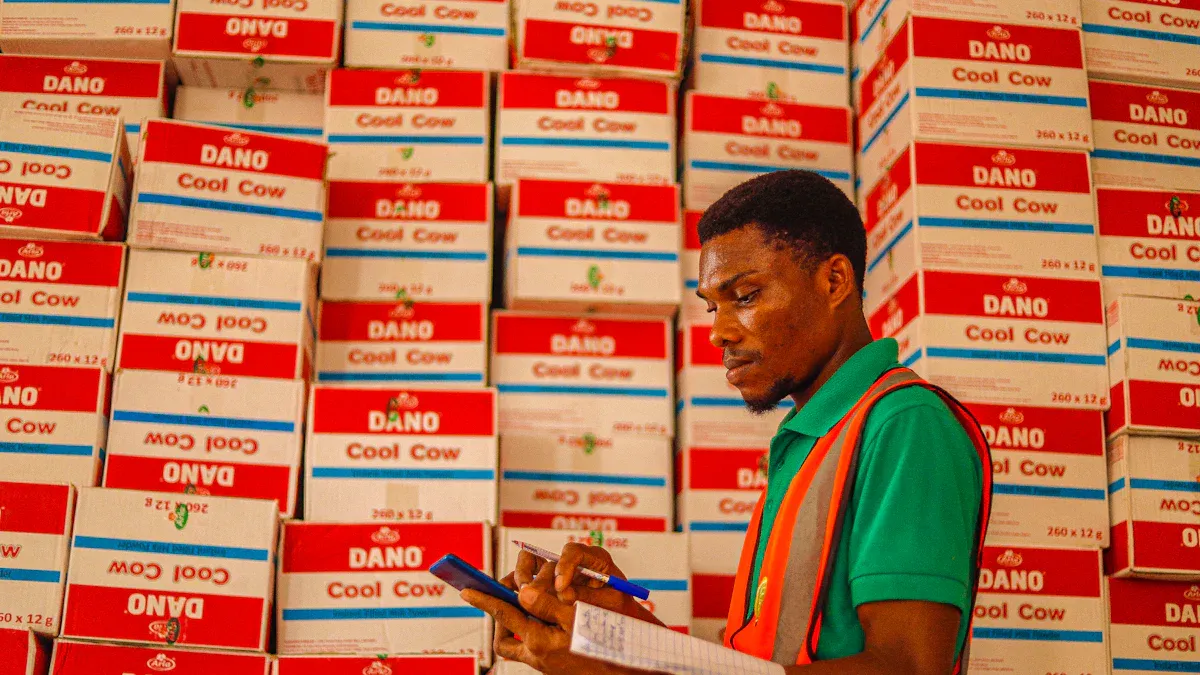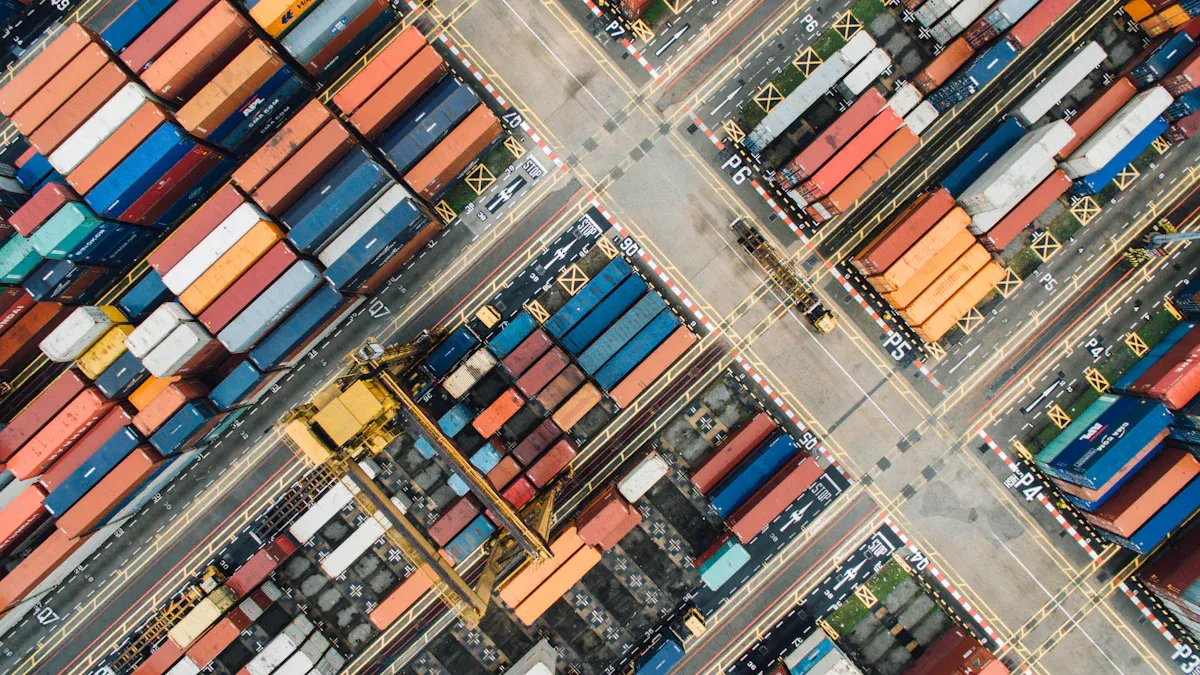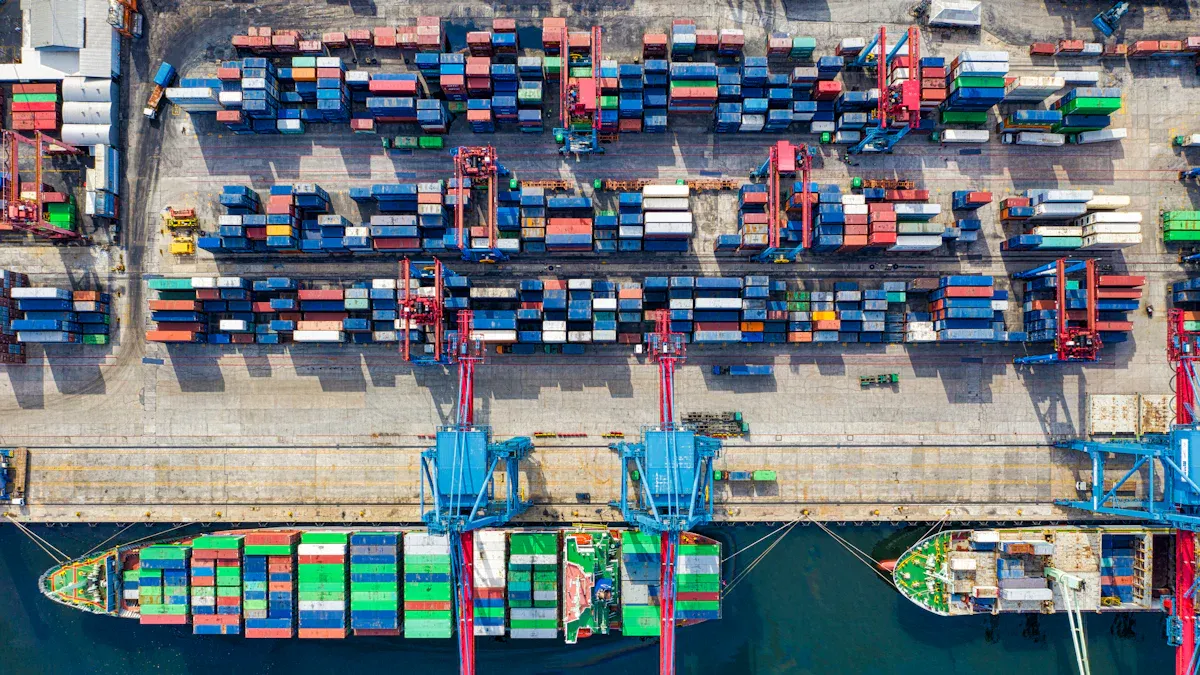Weighing the Pros and Cons of 3PL and In-House Logistics

You may wonder which is better for your business—outsourcing to a third-party logistics (3PL) provider or managing logistics in-house. A 3PL company handles storage, shipping, and order processing for you. In-house logistics means you control every step, from warehousing to delivery. Your choice often depends on cost, control, scalability, and expertise. For example, most businesses in the United States use 3PL services, while fewer bring logistics in-house.
Metric | Percentage |
|---|---|
Businesses using 3PL services | |
Businesses bringing activities in-house | 28% |
Businesses that previously insourced | 35% |
You should look at your business size, growth goals, and daily operations. Comparing the pros and cons of 3pl vs in house logistics helps you find the best fit.
Key Takeaways
3PL providers can save you money by handling logistics without the need for your own warehouse or staff.
In-house logistics give you full control over your processes, allowing for customization and quick responses to issues.
Consider your business size and growth goals when choosing between 3PL and in-house logistics to find the best fit.
3PL offers flexibility and scalability, making it easier to adjust to changing demand without heavy investments.
Evaluate both short-term and long-term needs to determine which logistics model aligns with your business strategy.
What Are 3PL and In-House Logistics?

3PL Defined
You may see the term "3PL" when you read about logistics. 3PL stands for third-party logistics. This means you hire a company to handle your storage, shipping, and order processing. You do not need to own a warehouse or manage delivery trucks. The 3PL provider takes care of these tasks for you.
3PL companies use their own systems and staff to make sure your products reach your customers. You can focus on growing your business while experts handle the details.
Industry experts say 3PL providers offer many core functions. Here is a table that shows what they do:
Core Function | Description |
|---|---|
Inventory Management | Tracks and manages your products so you always know what is in stock. |
Picking and Packing | Retrieves and packs orders with care, checking for quality and accuracy. |
Order Processing and Tracking | Handles order details and keeps you updated on shipping status. |
Shipping and Delivery | Uses strong delivery networks to get your products to customers quickly and at good rates. |
Returns Management | Processes returns and helps you manage items that come back. |
Value-Added Services | Offers extra services to make your logistics smoother and more efficient. |
You can benefit from these services if you want to save time and use expert help.
In-House Defined
In-house logistics means you manage every step yourself. You control your warehouse, staff, and delivery process. You make decisions about how products move from your business to your customers.
You gain full control over your logistics. You can set your own rules and make changes quickly.
Logistics management literature lists several main components of in-house logistics. The table below explains these parts:
Component | Description |
|---|---|
Transportation Planning and Routing | Plans the best routes and ways to move your products. |
Carrier Selection and Management | Chooses delivery companies and manages contracts. |
Freight Rate Management | Controls shipping costs and checks bills. |
Shipment Visibility and Tracking | Tracks shipments and keeps everyone informed. |
Load Optimization and Consolidation | Packs shipments to save money and reduce waste. |
Freight Documentation and Compliance | Handles paperwork and follows shipping rules. |
Risk Management and Contingency Planning | Prepares for problems and makes backup plans. |
Performance Analytics and Reporting | Measures results and finds ways to improve. |
Sustainability and Environmental Considerations | Looks for ways to protect the environment and use green practices. |
You may choose in-house logistics if you want more control and flexibility. You can build your own systems and adjust them as your business grows.
Pros and Cons of 3PL vs In-House Logistics

3PL Pros
When you choose a third-party logistics provider, you unlock several benefits that can help your business grow. You save money because you do not need to build or maintain your own warehouse. Many companies report that outsourcing logistics can cut supply chain costs by up to 25%. Most shippers say working with a 3PL helps them reduce expenses.
"Outsourcing logistics reduces operational costs by leveraging 3PL expertise and economies of scale, leading to cost-effective solutions and enhanced efficiency in supply chains."
You also gain access to advanced technology. 3PLs use transportation management systems and other tools to track shipments and optimize routes. This means your orders reach customers faster and with fewer mistakes. You can scale your operations easily. If your business grows or slows down, a 3PL can adjust resources without heavy investment.
Here is a table that highlights the main advantages:
Advantage | Description |
|---|---|
Cost Savings | You avoid expenses for warehouses and logistics staff. |
Improved Customer Satisfaction | Faster order processing and fewer errors lead to happier customers. |
Access to Advanced Technology | You benefit from the latest logistics tools and systems. |
Scalability and Flexibility | You can adjust logistics resources as your business changes. |
Enhanced Operational Efficiency | Streamlined processes improve order fulfillment and reduce mistakes. |
You also get expert help. 3PLs have specialized knowledge, so you can focus on your main business activities. This makes your company more productive.
Cost savings through better shipping rates
Scalability to meet demand
Expertise in logistics and technology
Ability to focus on your core business
Improved efficiency and productivity
3PL Cons
While 3PLs offer many benefits, you may face some challenges. You might lose some control over your supply chain. Sometimes, you cannot customize processes as much as you want. Communication gaps can happen, making it hard to track orders or solve problems quickly.
Here are common issues reported by businesses:
Shipping mistakes, such as wrong items or addresses
Limited visibility into inventory and order status
Poor communication with logistics partners
Unreported damages to products
Inaccurate receiving and miscounted items
Backlogs and lack of clear service agreements
Errors with special shipping standards, like FBA
Idle containers due to slow unloading
Geographic limits on warehouse locations
Inventory loss or theft
Drawback | Description |
|---|---|
Loss of Control | You may find it harder to maintain visibility and quality. |
Communication Gaps | You might not get updates or quick answers from your logistics partner. |
You should weigh these drawbacks when considering the pros and cons of 3pl vs in house logistics.
In-House Pros
Managing logistics yourself gives you full control. You decide how products move, pack orders your way, and set your own standards. You can customize packaging to match your brand and respond quickly to customer issues.
Here is a table showing the main benefits:
Benefit | Description |
|---|---|
Control Over the Process | You manage every step, ensuring quality and accuracy. |
Customization and Branding | You tailor packaging and shipping to fit your brand. |
Cost Savings | You avoid third-party fees, which can help small businesses. |
Faster Response to Issues | You solve problems quickly, improving customer service. |
Flexibility and Adaptability | You change processes to meet new needs or trends. |
Data and Insight Control | You access all logistics data for planning. |
Inventory Management | You track stock levels and product demand closely. |
Reduced Transit Times | You ship faster to nearby customers. |
Niche Product Handling | You manage special products with care. |
Learning Opportunity | You gain valuable logistics knowledge for future growth. |
You can also customize your logistics system. If you sell unique products, you can create special handling procedures. You get to know your customers and respond to their needs.
In-House Cons
Running logistics in-house can be tough. You need to invest a lot of money in warehouses, trucks, and staff. Small businesses may struggle with these costs. You also need expertise to manage logistics well. Without it, mistakes can happen.
Challenge Type | Description |
|---|---|
Financial Strain | You need a large budget for infrastructure and staff. |
Lack of Expertise | You may not have the skills to run logistics efficiently. |
Limited Scalability | Your system may not handle big changes in demand. |
Technology Challenges | You must buy and set up logistics technology, which can be hard. |
Risk Management Issues | You may find it difficult to prepare for problems or disruptions. |
You may also face delays if your team is small or busy. Scaling up can be slow and expensive. If you do not have the right technology, you may fall behind competitors.
Tip: When you compare the pros and cons of 3pl vs in house logistics, think about your budget, expertise, and growth plans. Each model has strengths and weaknesses. Your choice should match your business needs.
Key Factors for Decision
Cost
You need to look at both fixed and variable costs when comparing logistics options. In-house logistics often means you pay a lot upfront for warehouses, equipment, and staff. These costs stay the same, even if your business slows down. On the other hand, 3PL logistics lets you pay only for what you use. This can help you manage your budget better, especially if your sales change during the year.
Category | In-House Logistics | 3PL Logistics |
|---|---|---|
Setup Costs | Minimal upfront investment | |
Ongoing Operations | Fixed monthly costs, no matter the order volume | Flexible pricing that matches your demand |
Labor & Staffing | Salaries, hiring, and training for your own team | 3PL handles staffing and HR |
Tip: If you want to avoid large upfront costs, 3PL may be a better fit.
Control
Control matters if you want to set your own rules and keep your brand strong. In-house logistics gives you full control over every step. You can talk directly with your customers and make changes fast. You also get to choose your materials and timing, which helps if you care about things like sustainability. With 3PL, you give up some control, but you gain access to experts and flexible services.
In-house logistics lets you keep your standards high.
You can gather feedback from customers right away.
3PL offers less control but more flexibility.
Scalability
Scalability means how easily you can grow or shrink your logistics. In-house systems can be hard to scale. You may need to buy more space or hire more people. This takes time and money. 3PL providers already have the resources. They can handle more orders during busy times and scale back when things slow down. This makes it easier to adapt to market changes.
In-house: Scaling up takes planning and investment.
3PL: Scaling is quick and matches your business needs.
Expertise
Expertise helps you avoid mistakes and follow the rules. In-house logistics means you must train your team and keep up with new laws. This can be hard and costly. 3PL companies have trained staff and use advanced technology. They stay updated on rules and run regular checks to make sure everything is right. This keeps your business safe from fines and delays.
3PLs use advanced systems to track and manage shipments.
They train their teams to follow all industry rules.
They check their work often to avoid problems.
When you weigh the pros and cons of 3pl vs in house logistics, think about your costs, how much control you want, how fast you need to grow, and the level of expertise you need. Each factor can change what works best for your business.
Making the Choice
Assess Needs
You should start by looking closely at your logistics needs. Begin with clear goals for your logistics operations. Maybe you want to lower costs or deliver products faster. Talk with your team and other stakeholders to gather their ideas. Set SMART goals—these are Specific, Measurable, Achievable, Relevant, and Time-bound. Rank your goals by how much they help your business succeed.
Use a SWOT analysis to find strengths and weaknesses in your supply chain. Track important metrics over time to see how well your logistics work. Look for bottlenecks that slow down your process. Work with suppliers and distributors to make sure everyone is on the same page.
Tip: A data-driven approach helps you compare the total costs and benefits of each model. You can also ask logistics consultants for expert advice.
Short vs Long Term
Think about your business plans for both the short and long term. If you expect your order volume to change quickly, you may need a flexible solution. 3PL providers let you scale up or down without big investments. In-house logistics often require long-term commitments, like hiring staff or buying equipment.
Consider how complex your orders and packaging are. If you sell products that need special handling, in-house logistics may give you more control. If you want to grow fast, a 3PL can help you adjust your logistics capacity as demand changes. Many businesses choose 3PL for its technology and expertise, which saves time and money.
Factor | Short Term Needs | Long Term Needs |
|---|---|---|
Cost | Lower upfront costs | Investment in infrastructure |
Scalability | Quick adjustments | Long-term planning |
Expertise | Immediate access | Building internal skills |
Risk and Flexibility
You should weigh the risks and flexibility of each option. In-house logistics give you direct control and visibility, but you take on more risk. You must handle problems like staff shortages or equipment failures. 3PL providers share resources and spread out risks. They often have backup plans and advanced technology to keep things running smoothly.
Note: The pros and cons of 3pl vs in house logistics depend on how much risk you want to manage and how flexible you need your operations to be.
If you want to keep control and customize every step, in-house logistics may suit you. If you prefer to focus on your core business and let experts handle logistics, a 3PL offers more flexibility and less risk.
Choosing between 3PL and in-house logistics depends on your goals, budget, and need for control. 3PL offers flexibility, advanced technology, and cost savings, while in-house gives you more control and direct oversight. To decide, review these factors:
Capital investments
Efficiency and customer service
Flexibility and sustainability
Tip: Consult logistics experts, set clear goals, and use technology to track results. Regularly review your strategy to avoid common mistakes and keep your business moving forward.
FAQ
What is the main difference between 3PL and in-house logistics?
You use 3PL when you hire another company to handle your shipping and storage. You use in-house logistics when you manage everything yourself. The main difference is who controls the process.
Can small businesses benefit from 3PL services?
Yes, you can benefit from 3PL even if your business is small. You save money on warehouses and staff. You also get expert help and advanced technology.
Tip: Start with a small 3PL package to test if it fits your needs.
How do I know if I should switch from in-house to 3PL?
You should consider switching if you struggle with high costs, slow shipping, or lack of expertise. If your orders grow fast, a 3PL can help you scale up quickly.
Are there risks with using a 3PL provider?
Yes, you may lose some control over your products and processes. Sometimes, you face communication issues or delays. You should choose a trusted 3PL partner and set clear agreements.
See Also
Streamlined Inventory Management Through Premier Global Logistics Solutions
Selecting LTL, FTL, Or Drayage Services with PGL
Optimizing East Coast Import Warehousing and Delivery with PGL
